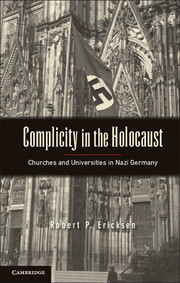Book contents
- Frontmatter
- Contents
- Acknowledgments
- Preface
- 1 Why the Holocaust Matters in a Century of Death
- 2 Churches and the Rise of Hitler
- 3 Universities and the Rise of Hitler
- 4 Consent and Collaboration
- 5 The Intellectual Arm
- 6 Repressing and Reprocessing the Past
- 7 A Closer Look
- 8 Implications
- Bibliography
- Index
- References
2 - Churches and the Rise of Hitler
Published online by Cambridge University Press: 05 June 2012
- Frontmatter
- Contents
- Acknowledgments
- Preface
- 1 Why the Holocaust Matters in a Century of Death
- 2 Churches and the Rise of Hitler
- 3 Universities and the Rise of Hitler
- 4 Consent and Collaboration
- 5 The Intellectual Arm
- 6 Repressing and Reprocessing the Past
- 7 A Closer Look
- 8 Implications
- Bibliography
- Index
- References
Summary
Two main churches existed in Germany when Adolf Hitler came to power. The Protestant church, which represented about two-thirds of the German people, included a Lutheran faction dominating the heartland and a smaller Reformed group strongest in the Rhineland. These two groups, which shared a great deal, continued to be separated by doctrinal differences first argued by Martin Luther and Jean Calvin in the sixteenth century. The Protestant situation was further complicated by an act of the Prussian king in the early nineteenth century. Tired of the doctrinal split, and no doubt also by its resonance in bureaucratic matters, he combined by fiat these two Protestant versions of the church into the “Old Prussian Union.” This variant of Protestantism then dominated the large and populous Prussian region in northern and eastern Germany, although within the Union there continued to exist separate identities. Some Lutheran and Reformed Protestants never fully accepted the carelessness about doctrine implied in a forced marriage.
The Lutheran Reformation and the Catholic Counter-Reformation of the sixteenth and seventeenth centuries, fought with both spiritual and military weapons, culminated in the Thirty Years War (1618–1648). Large portions of southern and western Germany retained their Catholic allegiance, notably in Bavaria in the south and in the Rhineland, but with pockets of influence elsewhere. Catholic bishops, clergy, and parishioners represented a strong minority within the Christian community in Germany and continue to do so. After Hitler’s Anschluss with Austria in 1938 (a merger greeted by many Austrians at the time, although widely disowned after 1945), the Austrian influx raised the Catholic portion of the German population to about 40 percent.
- Type
- Chapter
- Information
- Complicity in the HolocaustChurches and Universities in Nazi Germany, pp. 24 - 60Publisher: Cambridge University PressPrint publication year: 2012



